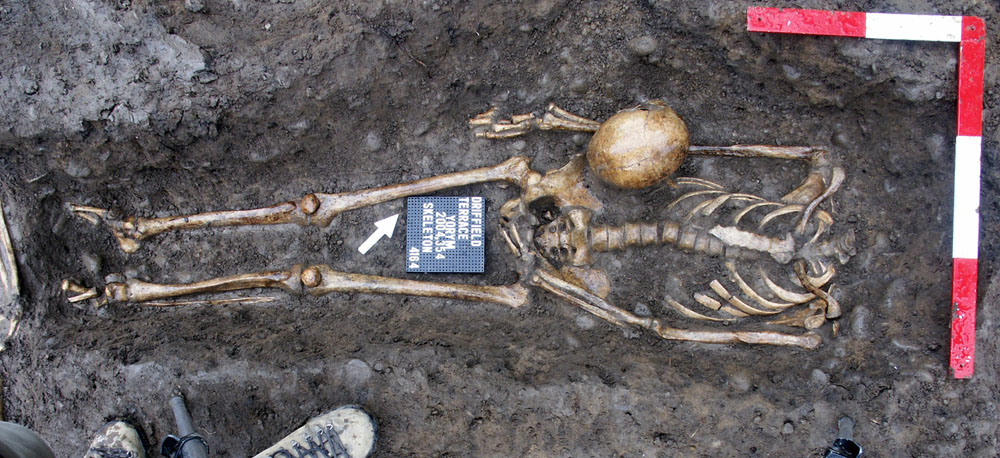Decapitated Gladiators Reveal Roman Empire's Genetic Influence

DNA from seven decapitated skeletons thought to be gladiators is helping researchers unravel the gruesome origins of the ancient remains. The new findings suggest that the Roman Empire's genetic impact on Britain may not have been as large as researchers had thought.
The headless skeletons were excavated between 2004 and 2005 from a Roman burial site in Driffield Terrace in York, England, the archaeologists said. Around the time the bodies were buried, between the second and fourth centuries A.D., the area that's now York was the Roman Empire's capital of northern Britain, called Eboracum. The cemetery where the bodies were discovered was located in a prominent area, near a main road that led out of the city, according to the researchers.
Most of the skeletons found at this site were of males younger than 45 who were taller than average and showed evidence of trauma, such as cuts to their arms and fingers, the archaeologists said. Famously, the majority of them had been decapitated. These standout traits led some experts to suggest that this was a burial site for gladiators. However, it is also possible that these men were in the military, which, in Roman times, had a minimum height requirement, the researchers said. [See Photos of the Decapitated Gladiator Skeletons]
"It was a very curious assemblage of individuals with their heads cut off, who may or may not be gladiators," said Matthew Collins, a professor of archaeology at the University of York and one of the paper's authors. The distinctiveness of these remains were featured in two documentaries in the years following the excavation, "Timewatch: The mystery of the headless Romans" in 2006 and "Gladiators: Back From the Dead" in 2010.
In the new study, Collins and his colleagues collected high-quality DNA samples from the dense petrous bone of the inner ears from the skeletons. In total, nine genomes were compared: seven from the York Romans (all male) and two from skeletons found in other cemeteries, including one from a more ancient Iron Age female and one from a more recent Anglo-Saxon male.
The genomes from the decapitated Romans were found to be similar to the Iron Age genome but significantly different from the Anglo-Saxon genome. This suggests that the Roman Empire's genetic influence on Britain was not nearly as strong as its cultural influence, the researchers said.
"We are used to the idea of the Romans coming in and changing things," Collins said. "Yes, they changed things, but the people fundamentally didn't change."
Get the world’s most fascinating discoveries delivered straight to your inbox.
The results also indicate that the arrival of the Anglo-Saxons during the Dark Ages had a greater effect on the genetic makeup of Britain than did the Roman Empire. Nonetheless, this period of history is still shrouded in mystery, the researchers said.
The new study also revealed that the York Romans were genetically similar to modern-day British Celtic populations, especially the Welsh. This makes sense, the researchers said, given the movement of people from central Britain to the margins of the country following Anglo-Saxon invasions. [Photos: Gladiators of the Roman Empire]
In addition to their more violent injuries, the Roman skeletons appeared to have experienced infections and childhood stress, the archaeologists said. Their genomes, in combination with evidence from studying different forms of elements (isotopes) and how they changed over time, showed that six of the seven were British, but one was from the Middle East, possibly Lebanon or Syria. This unexpected finding is an example of how dynamic the Roman Empire was — and brings to mind the present-day diaspora occurring in the Middle East, Collins said. It's likely that most of these men had brown eyes and black or brown hair, but one may have been blue-eyed and blond — the same as the Anglo-Saxon man, the researchers said.
These remains have been studied extensively, but the sequencing of their DNA is a major achievement, the researchers said. In their paper, they called this "the first snapshot of British genomes in the early centuries A.D." Collins said that the researchers couldn't have attempted such a feat when the skeletons were first discovered because the approximate cost would have been about $70 million. (With technological advances, the cost of such analyses has gone down, according to the Human Genome Project.)
Collins noted that the work exemplifies a new stage in archaeology. "The excitement is, we are now technologically able to do this kind of work, which is mind-boggling when you consider the great achievement of sequencing the first human genome was less than 15 years ago, and now we can sequence the genomes of Romans from York and Anglo-Saxons in Cambridge," Collins said. "It's just absolutely extraordinary."
The research is detailed online in the Jan. 19 issue of the journal Nature Communications.
Follow Live Science @livescience, Facebook & Google+. Original article on Live Science.


